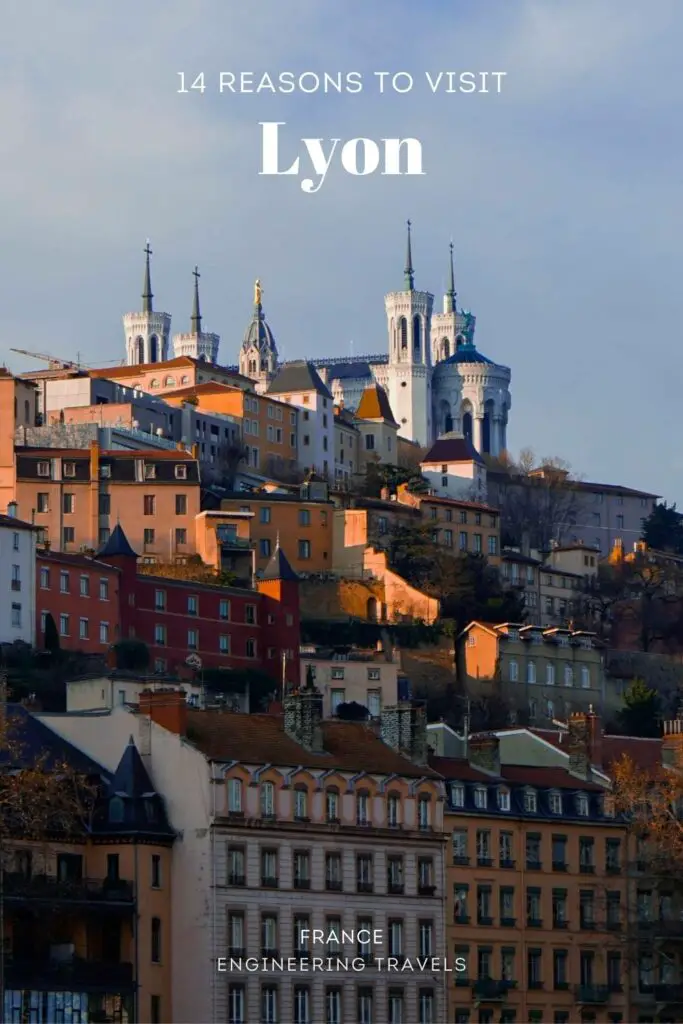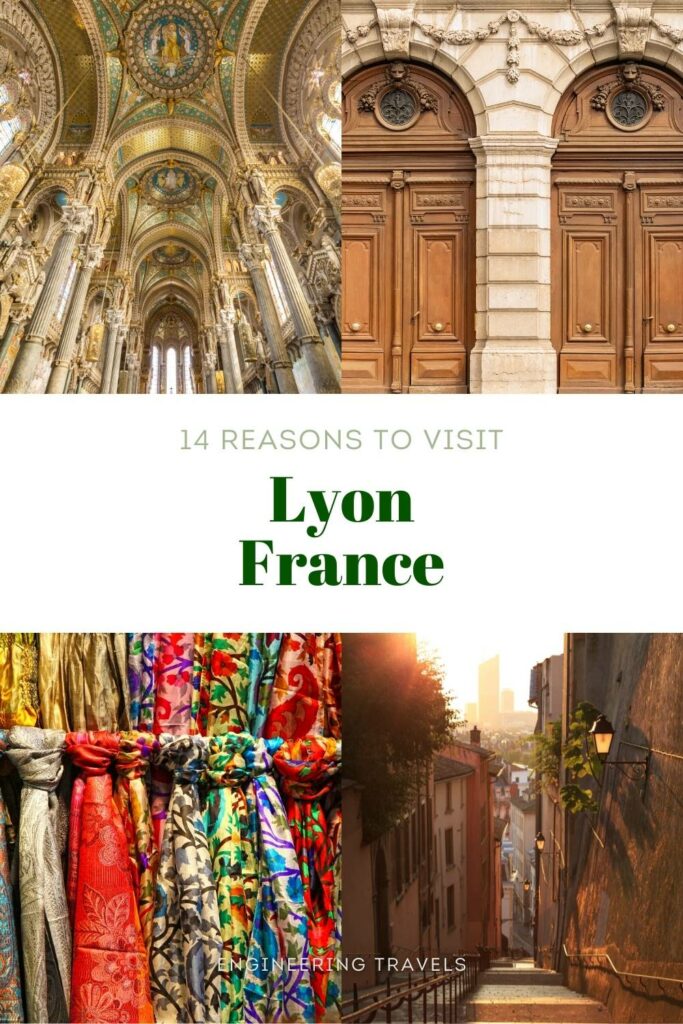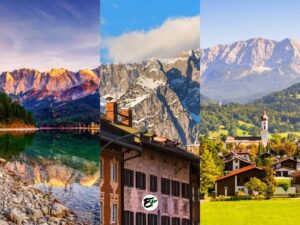What to Do in Lyon Besides Eating: 12 Awesome Attractions
With its reputation as the world’s gastronomy capital, Lyon is sure to satisfy all your food cravings. Lyon is a foodie’s paradise. Whether you’re dining at a Michelin-starred restaurant or grabbing a bite at a traditional bouchon, there’s a culinary adventure waiting for you at every corner.
And let’s not forget the bustling food markets! But, I’m not a food traveler. Should I still visit Lyon? If you’re asking yourself that, you’ve come to the right place.
In this post, we’re going to dive into the best travel experiences Lyon has to offer aside from gastronomy. I’ll help you find your reason why you’d visit Lyon. Let’s go!
This post contains affiliate links. I may receive a tiny commission at no additional cost to you.
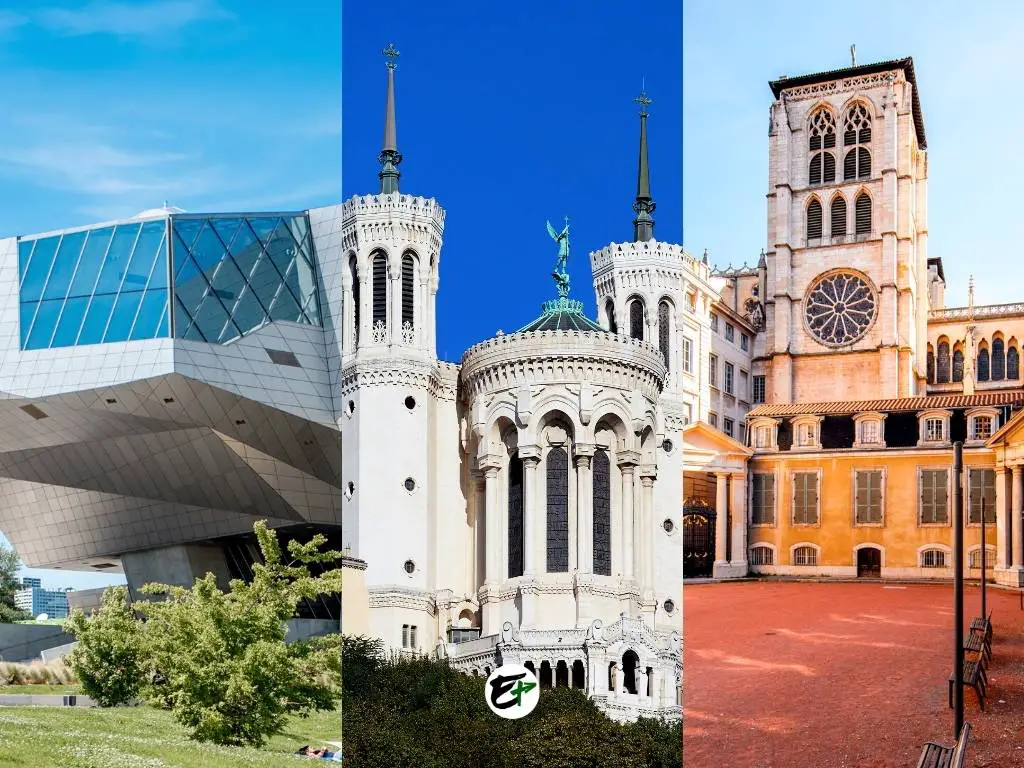
Use the table of contents to skip to topics.
More than just the world’s Gastronomy capital, Lyon is a city steeped in history and recognized as a UNESCO World Heritage site. Nestled in the heart of France’s Auvergne-Rhône-Alpes region, Lyon was established by the Romans in the 1st century BC and has played a pivotal role in shaping Europe’s political, cultural, and economic landscape.
Today, it’s France’s third-largest city and UNESCO describes it as an “exceptional testimony to the continuity of urban settlement over more than two millennia on a site of great commercial and strategic significance.”
Lyon has amazing architectural harmony and continuity, and they are key reasons for its UNESCO World Heritage status.
When you visit Lyon’s attractions and wander through its streets, you’ll discover many historic buildings that span various eras. This is what I find so fascinating about this city. Lyon transports its visitors back in time, from the modern era to the Renaissance, the Middle Ages, and, of course, ancient times.
Setting aside gastronomy, Lyon is city that appeals to those with an insatiable curiosity, a desire to discover something new at every turn, and an appreciation for the beauty inherent in historical sites. From the Roman amphitheaters to the Renaissance architecture of Vieux Lyon, and the modern Confluence district, every corner of Lyon tells a story.
The Basilica of Notre-Dame de Fourvière, perched atop Fourvière Hill, offers breathtaking views of the city, while the traboules – hidden passageways used by silk workers in the past – provide a glimpse into Lyon’s unique history. For architecture enthusiasts, Lyon is a visual feast. But there’s more…
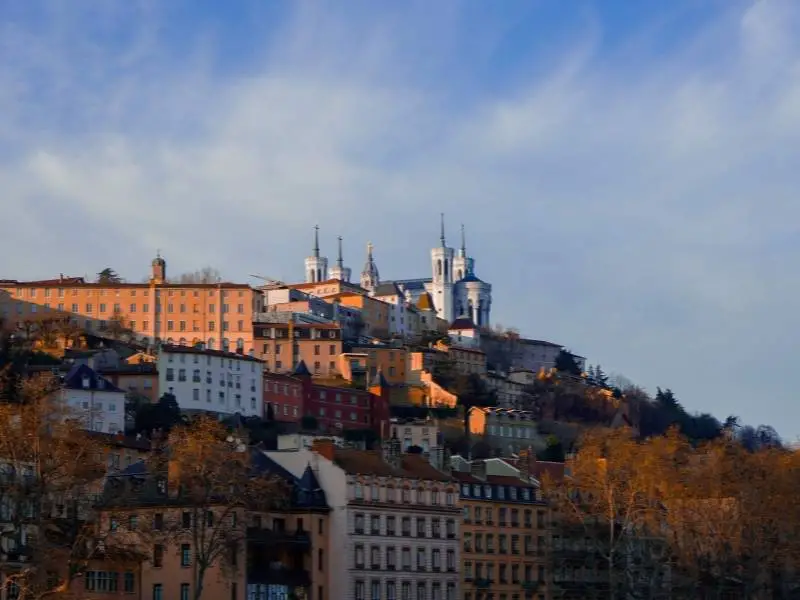
Also, did you know that Lyon is the birthplace of cinema?
Right here in Lyon, you can explore a museum that provides fascinating insights into the world of film. You’ll uncover a wealth of information about cinema, from its rich history to the vintage equipment used in its early days.
Have you ever come across those exquisite “Made in Lyon” scarves and ascots?
They’re renowned for their exceptional quality, and there’s a good reason for that. Lyon has been a hub for silk production for centuries, and they’ve truly mastered the art. In fact, they even have a museum entirely devoted to this industry. Come and explore it to uncover the secrets behind Lyon’s top-notch fabric products!
If you want to visit Lyon now, here’s the link where you can find the best hotel deals in Lyon. See the different ways you can explore Lyon with guides and tours here.
1. Lugdunum Roman Theaters
From a tourism perspective, Lyon holds a unique advantage over many other French cities due to its rich history spanning over 2000 years. It’s fascinating to realize that Lyon is home to attractions that harken back to ancient times, allowing visitors to embark on a journey through time using just their imagination.
Interestingly, Lyon was more than just a typical settlement in its early days. It held the prestigious position of being one of the most significant cities in the Roman Empire, serving as the capital of the region known by the Romans as Gaul.
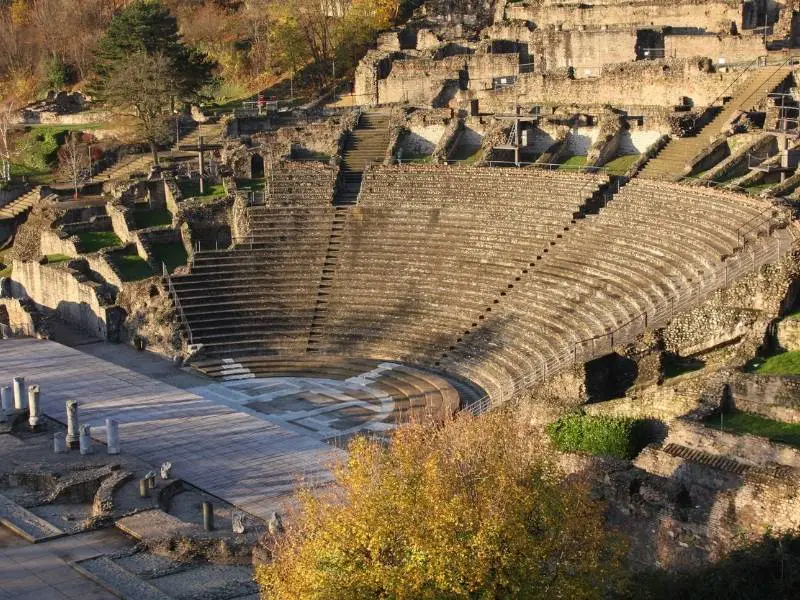
In the past, Lyon was known as Lugdunum to the Romans, serving as a hub of trade and power for centuries. With such prominence came impressive structures that symbolize the city. Two of these remarkable Roman-built structures, known as the Lugdunum Roman Theaters, still stand today. Some refer to them as the Ancient Theater of Fourvière due to their location on the hill of Fourvière.
The Lugdunum Roman Theaters consist of two theaters, both offering a panoramic view of the city below. The larger one is simply referred to as “the theater,” while the smaller one is known as “the odeon.” The theater, with its diameter exceeding 100 meters (328 feet), is not only the oldest of its kind in Roman Gaul but also one of the largest. It could accommodate over 10,000 spectators, hosting comedies, dances, and various plays.
On the other hand, the odeon had a smaller capacity of up to 3,000 spectators and was typically used for concerts, declamations, and smaller gatherings. Despite its smaller size, it stands out due to its construction materials. The orchestra pavement, in particular, is made of marbles sourced from various parts of the world: green porphyry from Greece, yellow marble from Africa, purple and red from Asia Minor, and red from Egypt.
What makes these theaters truly remarkable is their continued use for city events such as open-air concerts and festivals. Adjacent to these theaters is a modern museum housing an array of Roman pottery and artworks that provide further insights into ancient life in Lyon.
The last time I checked the official website of Lugdunum Roman Theaters, the theaters are open daily from 7:00 am until 7:00 pm. For the museum, here’s the schedule:
- Monday – Closed
- Tuesday to Friday – 11:00 am to 6:00 pm
- Saturday and Sunday – 10:00 am to 6:00 pm
The museum’s entry fees vary depending on the presence of temporary exhibitions. When such exhibits are on display, the admission fee is 7 EUR. However, in their absence, the fee drops to 4 EUR. If you’re interested in a more in-depth experience, you can opt for a guided tour at an additional cost of 3 EUR. Please note that entry is complimentary on the first Sunday of every month.
2. The Basilica of Fourviere
Just a stone’s throw away from the Lugdunum Roman Theaters, you’ll find Lyon’s crown jewel, the Basilica of Fourviere. Its breathtaking architecture is a sight to behold and a reason in itself to visit Lyon.
From a distance, the Basilica of Fourviere is a real head-turner, and up close, it’s absolutely awe-inspiring. And for the locals and Catholics, it holds a special place in their hearts. Legend has it that this church has performed miracles, protecting Lyon from wars and plagues. If you’re a believer and it’s your first time visiting, why not make a wish? Who knows, it might just come true!

Lyon’s salvation from the Bubonic plague is credited to the Virgin Mary, to whom the Basilica of Fourviere is dedicated. This divine intervention is also believed to have shielded the city from the Cholera epidemic and Prussian conquerors. These historical events have drawn millions of pilgrims to the basilica over time.
Today, this church also serves as one of Lyon’s top attractions. Its stunning architecture, coupled with its prime location atop Fourviere hill, draws around 2.5 million visitors each year.

While the Basilica of Fourviere may be relatively young compared to the Roman theaters, having been built and consecrated only in the mid-to-late 19th century, its expressiveness is on par with other renowned European churches.
To put it simply, the basilica is steeped in symbolism, which is manifested in various ways. Its position overlooking the city gives it an impression of being a guardian watching over Lyon. To truly appreciate its symbolic stature, head to the bridges in Vieux-Lyon, or Old Lyon, and look westward. The sight of the basilica standing tall against the skyline is a sight to behold, especially at night when it glows over the city.
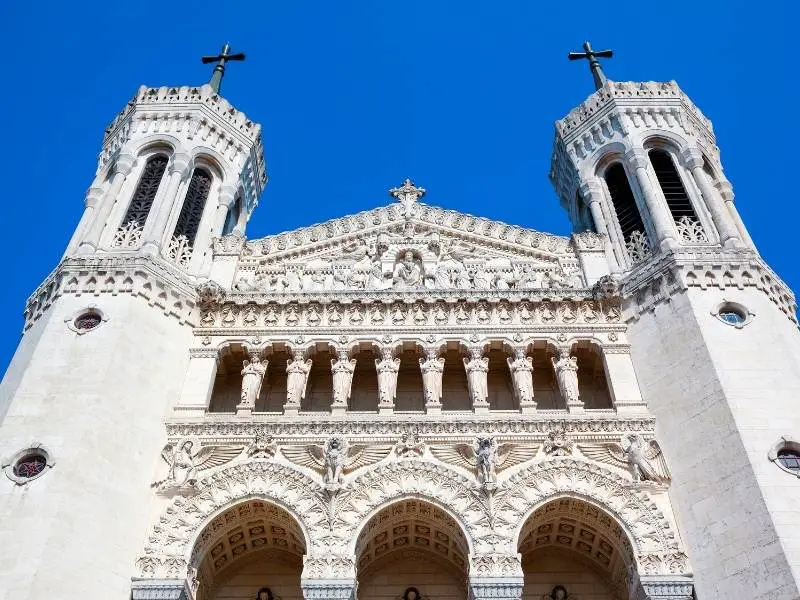
The structure of the basilica itself is steeped in symbolism. Its four towers, each soaring to a height of around 48 meters, represent the cardinal virtues: Prudence, Force, Temperance, and Justice. On a clear day, you can ascend the north tower to behold panoramic views that stretch all the way to Mont Blanc.
But before you can access the tower, you’ll be greeted by the stunning magnificence of the basilica’s facade. Adorned with intricate reliefs and sculptures of angels and saints, again, this church a sight to behold. The tympanum features a glowing figure of the Virgin Mary, which shines brightest at night.
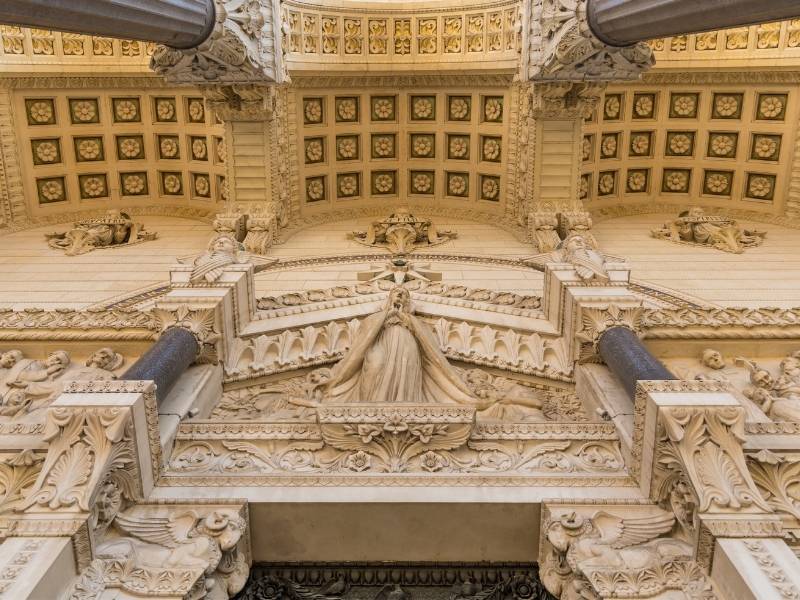
As you step through the main portal and into the upper level of the Basilica of Fourviere, your eyes will be dazzled by the sight that greets you. The interior is a stunning blend of Romanesque and Byzantine styles, creating an atmosphere that’s truly unique. The exquisite golden and blue mosaics, elegant marble columns, and vibrant stained-glass windows are nothing short of awe-inspiring.

Once you set your eyes on the ceiling of the nave, choir, and apse, you won’t be able to look away! The walls are a visual feast too, adorned with mosaic artworks that depict various scenes from Christendom in France. And make sure you don’t miss the altar – it features a stunningly beautiful depiction of Mary.
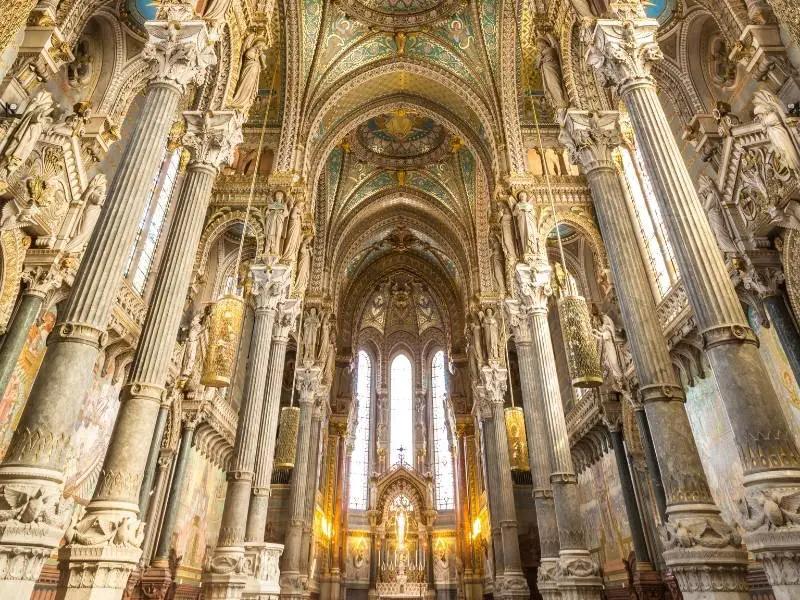
According to the official website of the Basilica of Fourviere, the church welcomes visitors from 7:00 am to 7:00 pm at no charge. However, please note that during Holy Mass, visitors are requested not to wander around the church. For more details, please refer to the link provided.
3. Vieux-Lyon
Lyon may have embraced modernity, but it hasn’t completely let go of its medieval roots. If meandering along cobblestone paths or photographing the timeless elegance of a medieval city appeals to you, then you’ll find another reason to visit Lyon – the enchanting district known as Vieux-Lyon, or Old Lyon.
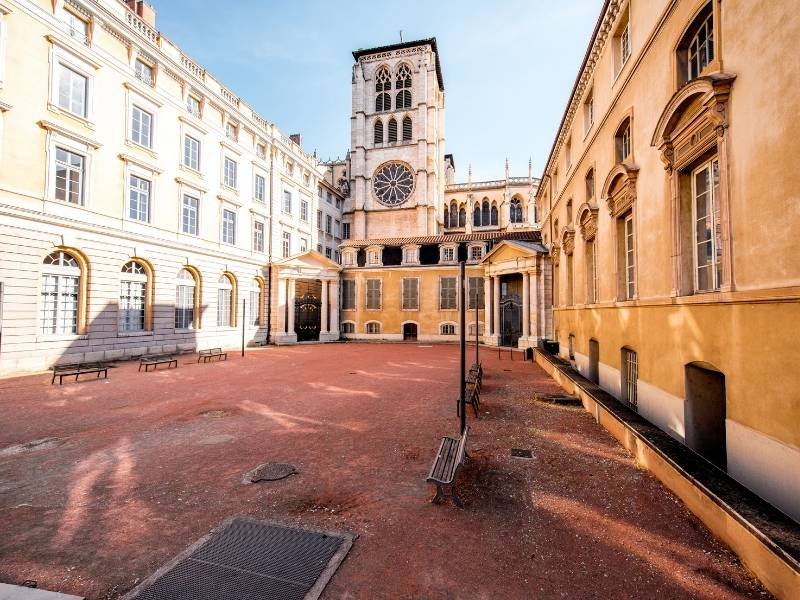
Vieux-Lyon, or Old Lyon, is a living testament to the city’s rich history. It’s akin to an open-air museum. As you wander its narrow lanes and admire its historic buildings, you’ll feel as though you’re stepping back in time, experiencing firsthand the city’s evolution over two millennia.

In Vieux-Lyon, while you can discover a wealth of buildings that span from the early 12th century to the early 20th centur, it’s the houses from the Renaissance period that truly stand out. And it’s no surprise, considering Lyon is home to one of Europe’s most extensive Renaissance neighborhoods!
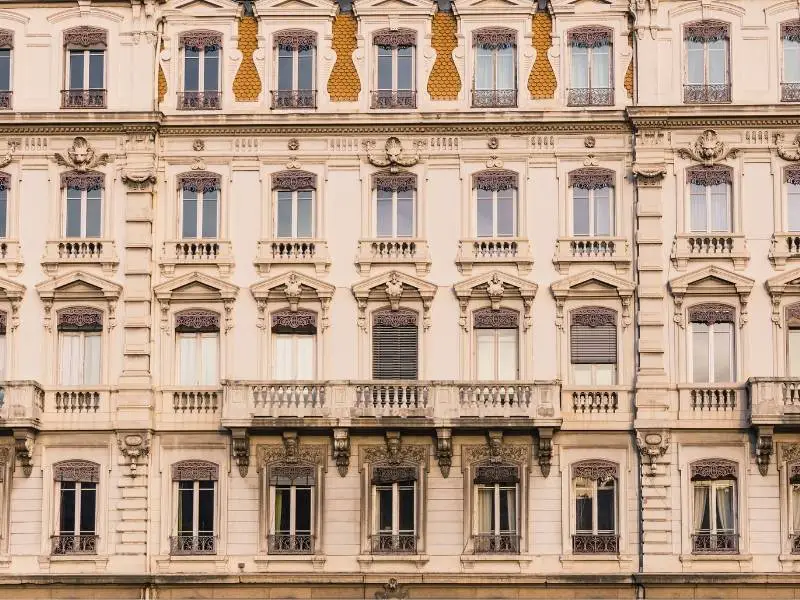
Did you know that Vieux-Lyon is considered one of France’s most significant heritage sites? Its cultural importance was recognized by the French government long before it was designated a UNESCO site. In fact, Vieux-Lyon holds the distinction of being the first site in France to be protected under the Malraux Law, a legislation enacted to safeguard the country’s cultural sites.
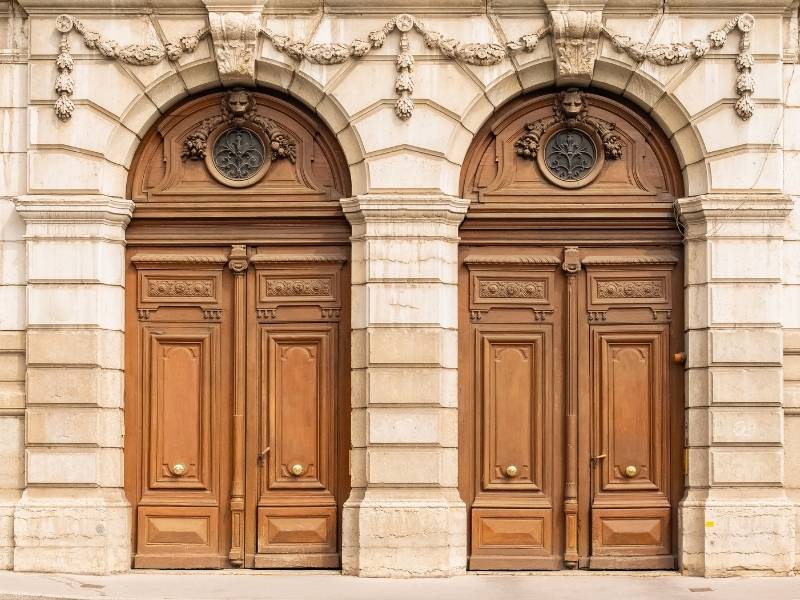
Actually, Vieux-Lyon is an attraction that houses numerous other attractions. Beyond the picturesque streets such as Rue St-Jean and Rue Juiverie, ideal for a relaxing walk, Vieux-Lyon is home to a host of significant landmarks and museums, each brimming with unique discoveries.
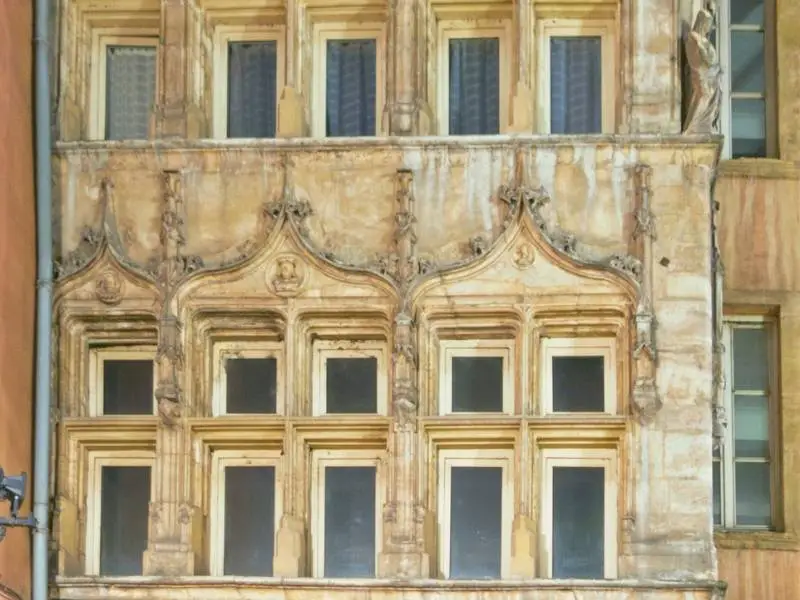
Should your travels take you to Vieux-Lyon and you have a penchant for history, make sure to visit the Cathedral of Saint-Jean, commonly known as Lyon Cathedral. This church, built in the Gothic style and dating back to the 15th century, holds a special place in history. It was here that King Henry IV and Marie de Medici exchanged their wedding vows in 1600.
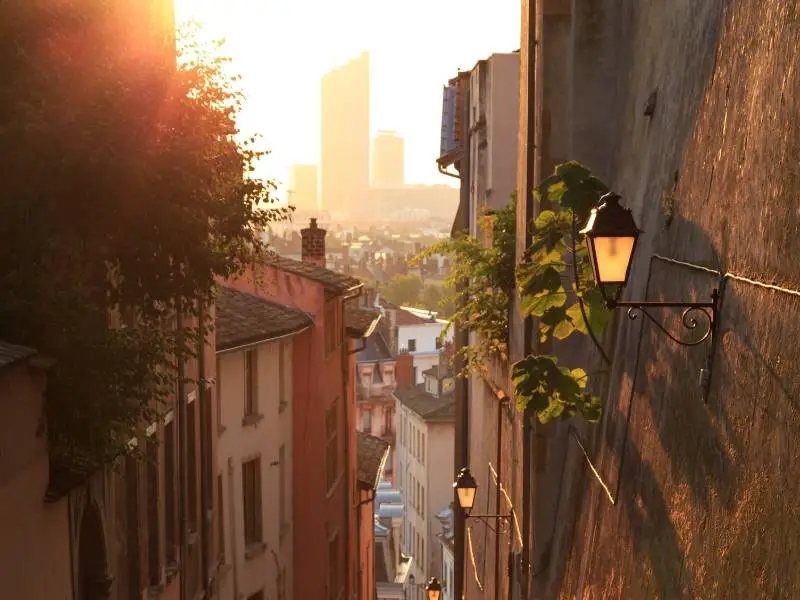
Another notable building in Vieux-Lyon is the Gadagne Museum. It’s the largest Renaissance building in the old district and now houses Lyon’s history museum and puppet museum. It also has a cozy-medieval restaurant and garden for a relaxing break after exploring Vieux-Lyon.
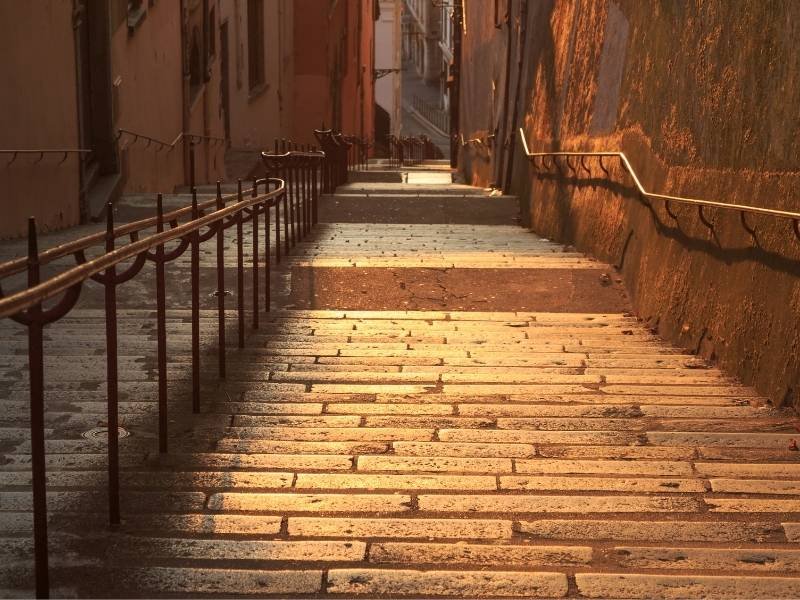
Some locations transport you back to various eras. For instance, a visit to Place du Change offers a glimpse into the vibrant life of Vieux-Lyon. This place served as the city’s economic hub during the 15th and 16th centuries.
If you love old historic centers of a city like Vieux-Lyon, you must also see Colmar.
4. Courtyards & Traboules
Isn’t it exciting to visit a place that has something unique to offer? We all love discovering new things and having special experiences.
If you’re nodding along, then Lyon is just the place for you. It’s got its own charm and distinctive features that make it a must-visit. I’ve already told you about the cinema and silk industry, right? And guess what, there’s more! ‘Traboules’.
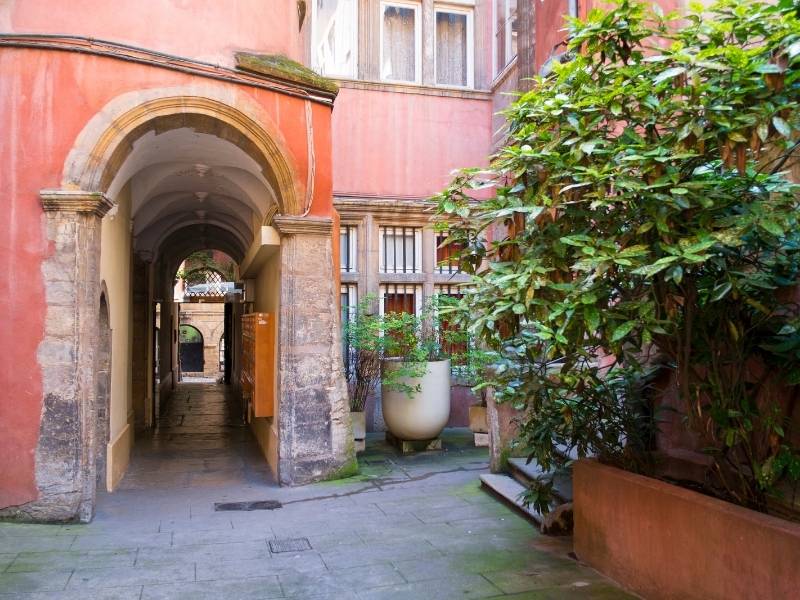
You might be wondering, “What on earth are traboules?” Well, they’re secret passageways that connect streets and courtyards. Some even lead to Italian-style galleries, tranquil gardens, picturesque spiral staircases, towers, and more!
There are a lot of traboules in Lyon, hundreds of them! Can you believe it has more traboules than streets? In fact, there are around 500 traboules in Lyon, with 200 of them in Vieux-Lyon alone.
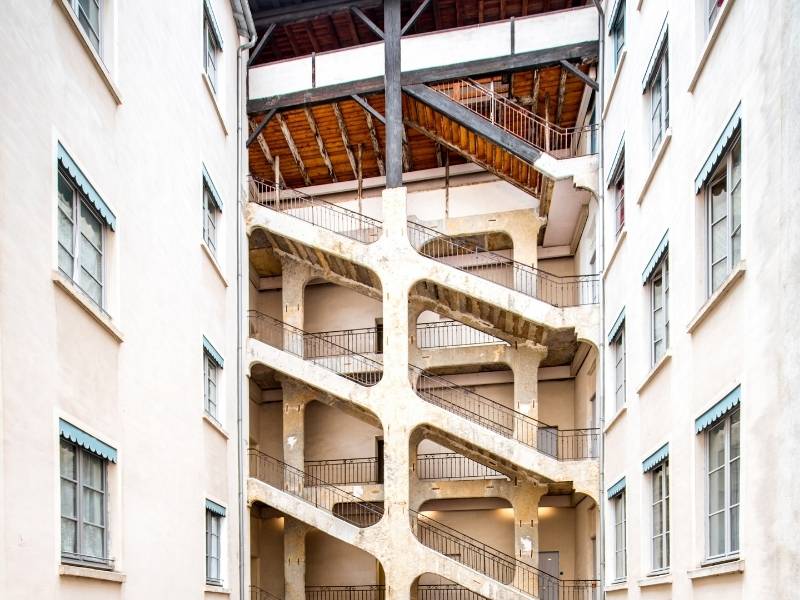
Back in the day, traboules were the secret highways for the canuts, who were the silk workers in Lyon, as well as for merchants and craftsmen. These hidden passageways gave them a safe haven from bad weather as they moved their goods from home to market.
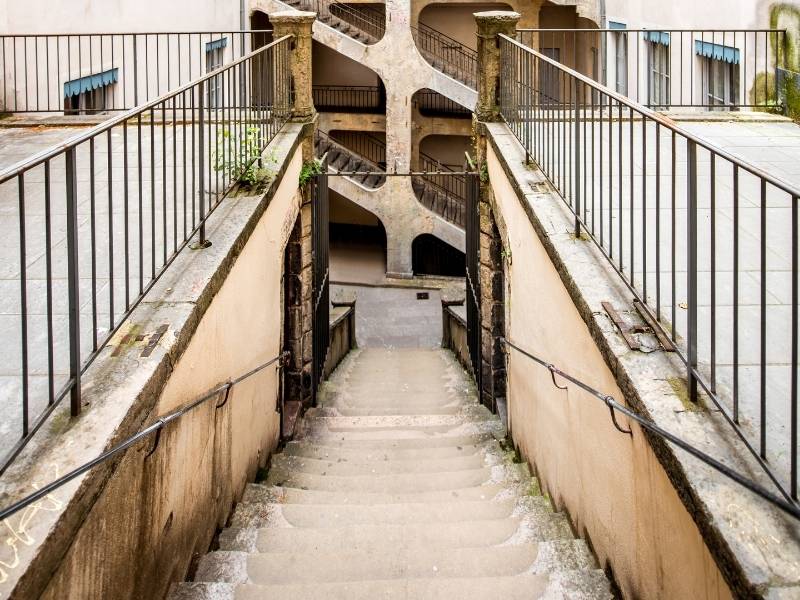
You might be excited to explore all the traboules in Lyon, but keep in mind that many of them are part of private properties and aren’t accessible to tourists and travelers. But don’t worry, there are still about 80 traboules that you can visit!
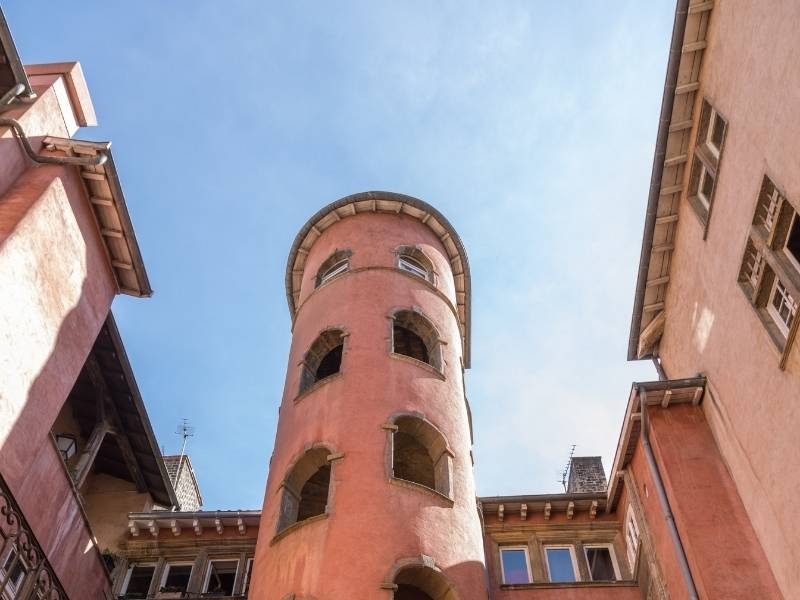
If you’re wandering around Vieux-Lyon, you might stumble upon the Grande Traboules at 27 Rue du Bœuf. It’s the longest traboule in the area! And it’s just a stone’s throw away from Lyon Cathedral and close to the Musée Cinéma et Miniature. The Grande Traboules is quite a sight as it runs through the courtyards of four buildings.
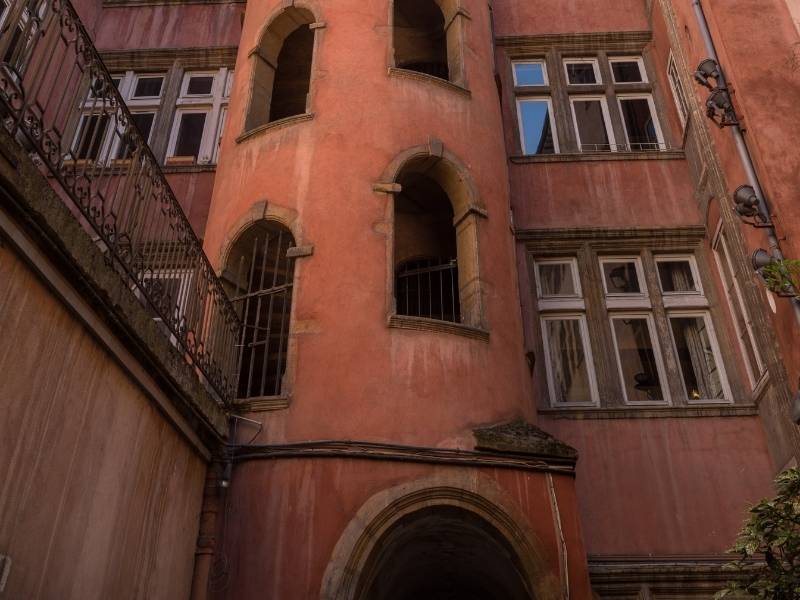
Wondering where to find these accessible traboules? Well, you can always pop into Lyon’s tourism information center. They’ll point you in the right direction. But hey, there’s an even easier way! Just download the Traboules app by Lyon Tourism and Conventions on your smartphone. It’s pretty cool – it uses augmented reality and a map to help you discover traboules in Lyon.
5. Cathédrale Saint-Jean-Baptiste
Are you the kind of person who loves diving into the history of Christianity? If so, Lyon is calling your name. You’ve got to check out the Cathédrale Saint-Jean-Baptiste, or Lyon Cathedral.

Why? Cathédrale Saint-Jean-Baptiste is not just a beautiful building, it’s a place steeped in history and religious significance. Remember when I mentioned that King Henry IV married Marie de Medici there in 1600? But that’s not all! The cathedral was also the venue for two major events in the Catholic Church – the First and Second Council of Lyon, which took place in 1245 and 1274.
These were huge gatherings where bishops from all over, and even old-world kings like Baldwin II of Constantinople, came together to address the challenges facing the largest religion in the world.
Trivia: Lyon is the place where the ecumenical council took place. But it was in Avignon where the popes in the 14th century resided.
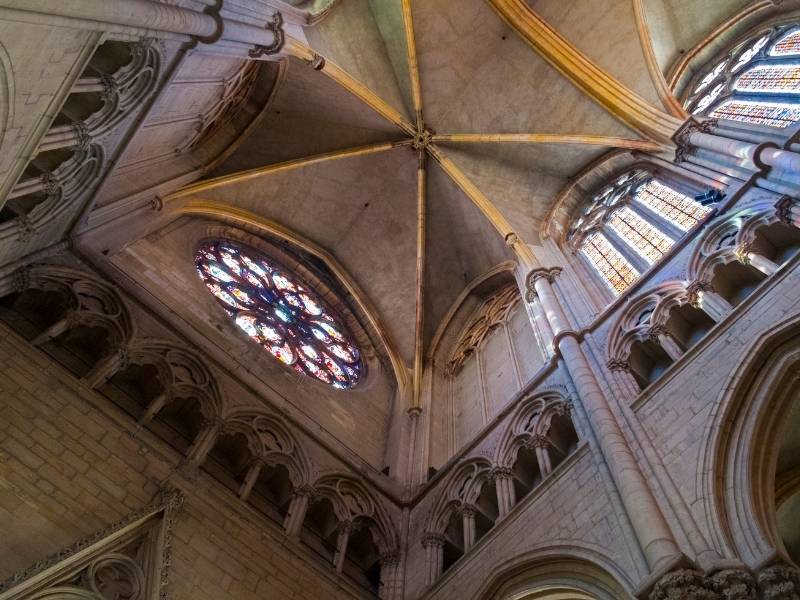
The cathedral you’ll see if you visit Lyon might not be the exact same one that those noblemen saw back in the day. That’s because it wasn’t completed until 1480. But isn’t it amazing to think that you’re walking in the same place where they once stood?
Today, Lyon Cathedral is a beautiful blend of architectural styles. It boasts a stunning gothic facade, while the interiors, especially the apse and choir, showcase Romanesque designs. The most symbolic parts of the church are the crosses on either side of the altar. They symbolize the Church’s union, a key issue discussed during the Council of Lyon. And guess what? They’re over 700 years old!
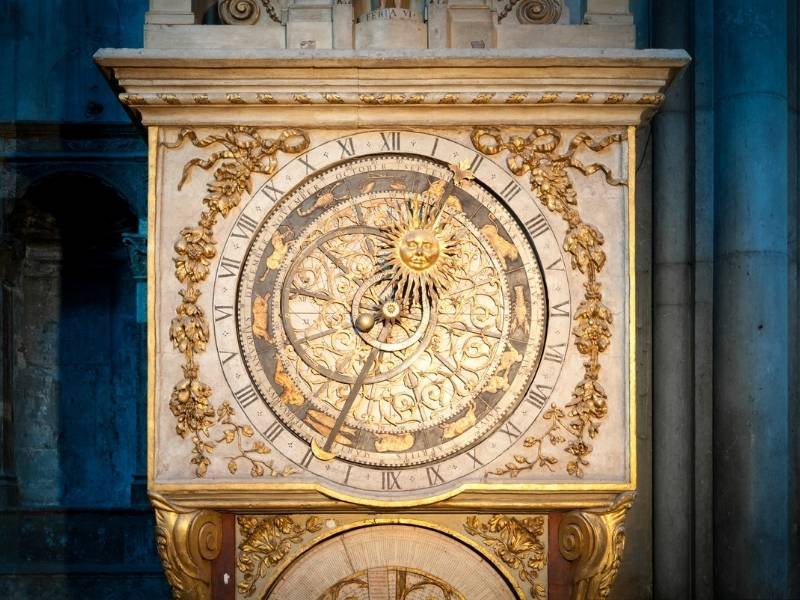
Did you know that Lyon Cathedral is home to another treasure that’s almost as old as those crosses beside the altar? It’s the 14th-century astronomical clock, which is the star attraction of the cathedral.
However, this isn’t just any old clock. It’s got all sorts of fascinating features. It has an astrolabe that shows what the earth looked like back when people believed in geocentrism. It can even tell you the phases of the moon and stars above Lyon on specific days. And get this – it can also tell you the day of the week using an automaton!
The days are represented by various images of Mary, Saint John the Baptist, and Jesus. Plus, it has a perpetual calendar, although it might need a bit of an update – last time I checked, it was stuck in 2017.
You’re free to wander around Lyon Cathedral and check out all the amazing things I mentioned, but just make sure there’s no Holy Mass happening at the time. The cathedral welcomes visitors all year round from 8:15 am until 7:45 pm. Oh, and on Saturdays and Sundays, they close up shop a little earlier at 7:00 pm.
6. Lyon Trompe-l’oeils and Murals
Remember when I said Vieux-Lyon is like an open-air museum? Well, it turns out, it’s not just old Lyon – the whole city is a living canvas! The city is adorned with artworks that cover many of its buildings. These aren’t just for show, they tell the story of Lyon’s past, present, and future.
What’s really mind-blowing about these murals? It’s their sheer size and unique style. Take the Wall of the Canuts for example – it’s a whopping 13,000 square feet or 1207 square meters wide, making it one of the largest murals in Europe.
The Wall of the Canuts is a real eye-catcher with its Trompe-l’oeil style that tricks your eyes into seeing it as three-dimensional. It’s like stepping into a parallel universe where time stands still – it’s absolutely stunning!
Lyon is also home to the Famous Faces of Lyon Fresco, another giant mural. This one covers a whopping 8600 square feet or 800 square meters and features famous French personalities from Lyon’s 2000-year history.
These people are portrayed as if they’re socializing on the balconies of the building, which are paintings too. Since this mural also depicts Lyon’s influential personalities and contributions, it can serve as your introduction to Lyon if this is the first thing in your itinerary.
The CitéCréation, the organization that painted these murals, has also applied the Trompe-l’oeil style in Famous Faces of Lyon Fresco. It should make you think twice if the facade of the building is real or a well-decorated flat surface.
Other murals in Lyon depict the history of the Silk trade, transportation in the city, and biblical scenes. If you go to Place Mendès France, you can find the mural showing the three towers of Babel.
Along Jean Jaurès avenue, however, lies the mural visualizing the future of Lyon in 2046 called the Light Wall Painting. If you want to learn more about these murals in Lyon, you may check this article on the official tourism website of Lyon.
7. Fête des Lumières
Remember how we marveled at Lyon’s buildings and their mesmerizing murals? Well, hold on to your hats because the city itself becomes a canvas for a spectacular light show once a year! This happens during the Fête des Lumières, making winter a fantastic time to visit Lyon.
The Fête des Lumières, or Festival of Light, is a celebration that happens every December 8th on the feast of the Immaculate Conception. This tradition has been around for about 400 years, starting when the échevins, or municipal councilors of Lyon, made a vow to Mary.
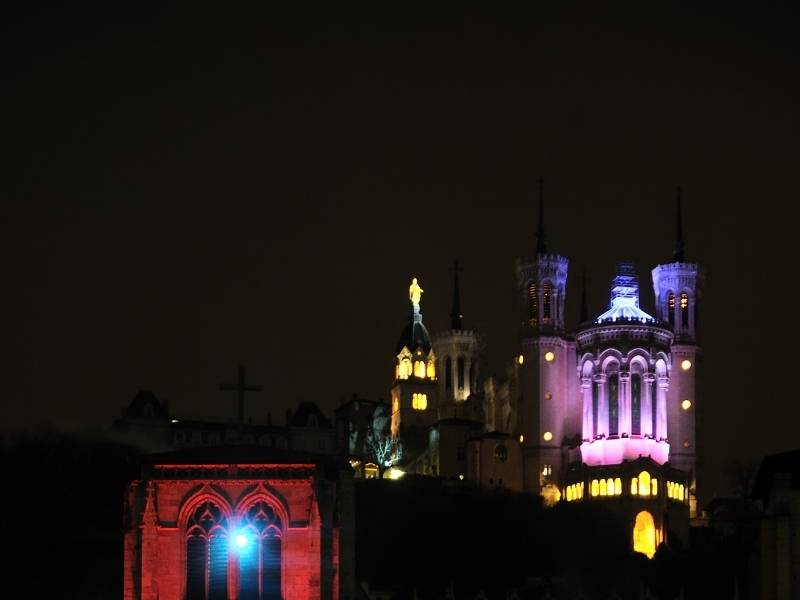
They promised that if Lyon were spared from the plague, they would light candles and give offerings.

Amazingly, this tradition is still alive and well today. During the Festival of Light, you can see candles flickering on the windowsills of houses all over the city. And it’s not just about watching – many people join in the procession to the cathedral in Fourviere to light their own candles.
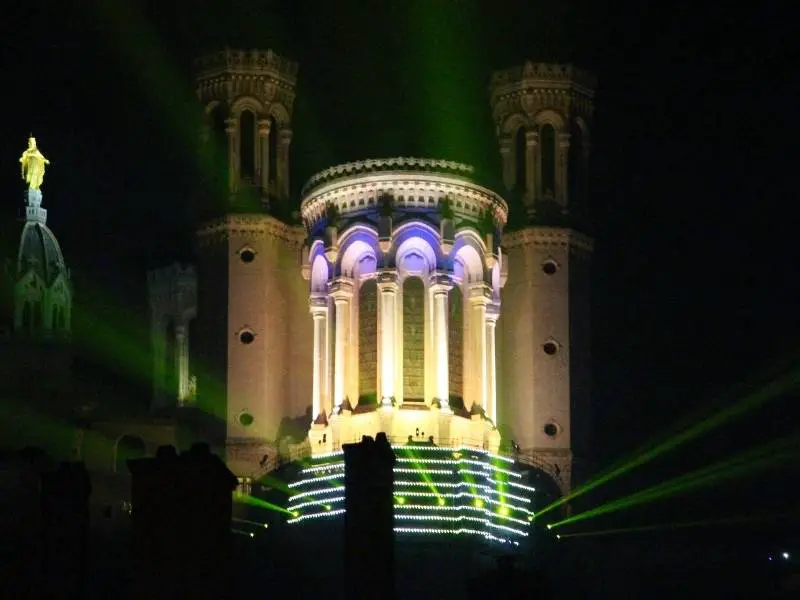
Lighting candles and joining the procession are just the beginning of the Festival of Lights experience.
The real magic happens when the performances and light shows begin. Imagine this – public spaces in Lyon exploding with color, and building facades transformed by artistic light projections. It’s like the whole city becomes a canvas for a spectacular light art show!
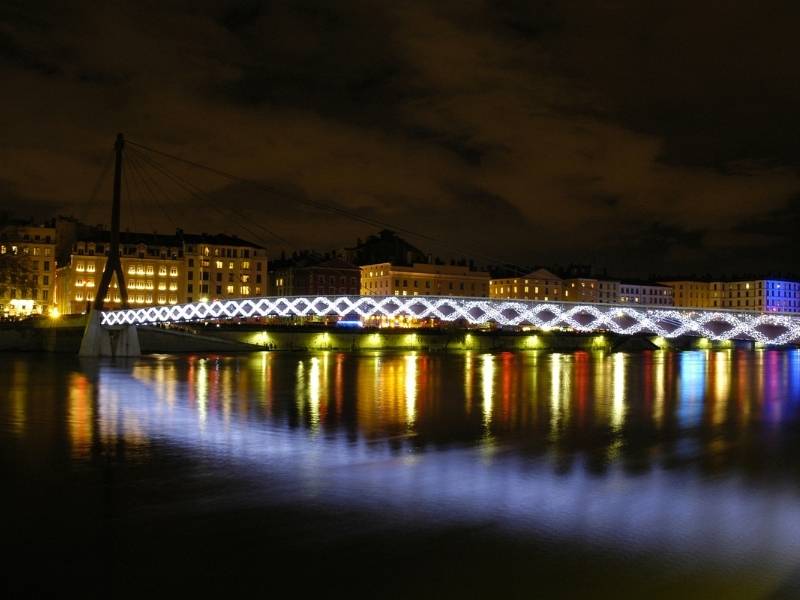
The Festival of Lights goes on for four days, so you’ll have plenty of opportunities to catch different light shows all over the city. However, there are two shows that you absolutely can’t miss. The first one is at Place des Terreaux and the second one is at the Basilica of Fourviere. They’re the most spectacular!
More than three million people usually attend Lyon’s Festival of Lights. If you want to join this year’s celebration, here’s the official website of the Festival of Lights. Dates, schedules, and other announcements are posted on the website.
Did you know that the stunning Basilica in Reims — the church where the kings of Frence were crowned — has a light show similar to Lyon’s?
8. Fine Arts Museum
Lyon is like a living, breathing work of art. With murals adorning its streets and the city lighting up once a year for the Festival of Lights, it’s a haven for art lovers. And if you’re looking for some artistic inspiration, Lyon is the place to be.
Did you know it’s home to the largest fine arts museum in France after the Louvre? It’s called the Museum of Fine Arts of Lyon, or Musée des Beaux-Arts de Lyon. If you want a sneak peek, there’s a YouTube video that gives a great visual introduction.
While it may not be the largest in the country, Lyon’s Fine Arts Museum is packed with enough treasures to make it a must-visit. Just like the city it’s nestled in, the museum is a gateway to fascinating discoveries that span centuries and even millennia.
The last time I checked, one of the oldest items in Lyon’s Fine Arts Museum was an Egyptian net-painted cylinder vase. Can you believe it’s over 5000 years old? It’s a relic from Egypt’s protohistoric period! You’ll also find an array of paintings, sculptures, and graphic art. And let’s not forget the unique medallion and objets d’art collections.
So, if you’re looking for a reason to visit Lyon, this museum definitely is!
In essence, visiting the Fine Arts Museum in Lyon is like taking a trip through time and art history. And it will take place as you wander through a 17th-century former Benedictine convent with 70 rooms, each one telling a different story.
The journey isn’t just about art only, though, but it’s like stepping into a time machine that takes you back to where human civilization began. From Egypt to ancient Greece, Italy, the Middle East, and the Far East – it’s all there. And let’s not forget the genuine objets d’art treasures from the 20th century.
The Fine Arts Museum in Lyon also houses exquisite ceramics from Islamic countries to Far-Eastern territories, showcasing incredible art and design. These pieces, particularly the ceramics from the Islamic regions, are absolutely unmissable. The collection also features Renaissance earthenware and Byzantine ivories, offering insights into diverse global heritage and cultural art forms.
Did you know that Lyon’s Fine Arts Museum also boasts the second-best numismatic collection in France? As you wander through the museum, you’ll come across artistic medallions, coins, seals, and more, each telling a story of trade and recognition in various places throughout history.
What can thrill every art lover to visit the Fine Arts Museum of Lyon?
Its collection of paintings and sculptures. Its paintings and sculptures date back to different eras. The artworks are made by famous artists, Picasso, Manet, Monet, Véronèse, and more.
If you want a glimpse of the collections you can find in Lyon’s Fine Arts Museum, check their official website here. You can browse for the stuff I’ve mentioned above from your device. But, of course, the experience would be better if you could see them in person!
The Museum of Fine Arts of Lyon is open daily except for Tuesdays and holidays. It accepts visitors from 10:00 am until 6:00 pm (it opens late at 10:30 am on Fridays). The entry fee starts at 8 EUR per adult. Please check all the visiting information on the ticketing page of the museum’s website before going.
9. Musée des Confluences
The beautiful artworks you can find in Lyon come in many forms. They include murals, light shows, paintings, sculptures, and more. Of course, we can also admire architecture as an art form in Lyon. The Fourviere cathedral and the preserved medieval buildings in Vieux-Lyon are good examples.
With these attractions in Lyon, and landmarks dating back centuries, it is easy to assume that Lyon is only for certain travelers. We can conclude that Lyon is worth visiting especially if you are interested in history and traditional artworks. However, Lyon’s Confluence Museum changes this presumption.
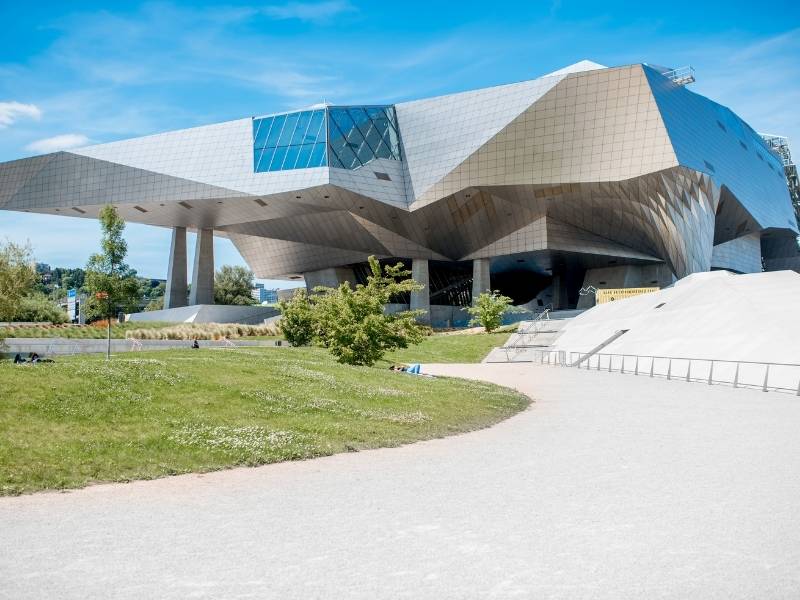
The Confluence Museum, Lyon’s newest and most modern museum, is a game-changer for the city’s travel scene. It’s a must-visit for those with a passion for contemporary architecture, science, nature, and animals.
But what exactly is the Confluence Museum? It’s a beacon of knowledge transfer, housed in an awe-inspiring deconstructivist building that seems to float like a crystal cloud of stainless steel and glass. This striking, futuristic design is set to transform Lyon’s image in the minds of its visitors.
Imagine stepping out of the Roman theaters and into the Confluence Museum – it’s like being catapulted into the future! Isn’t it fascinating to think that you can have such a diverse experience without having to travel to multiple cities?
The Confluence Museum in Lyon, with its stunning modern architecture, consistently leaves a lasting first impression on its visitors. But that’s just the beginning of the rich experiences that await you at the museum.
True to its vision, the Confluence Museum houses a wide array of collections that offer insights into various subjects. And it’s not your typical museum with exhibits displayed in standard glass boxes and frames. As a modern museum, it offers interactive platforms for a more engaging learning experience.
As I’ve mentioned before, the Confluence Museum is a sanctuary of enlightenment. It sheds light on an array of disciplines such as natural sciences, anthropology, ethnography, zoology, and paleontology, just to list a few.
It essentially paints a holistic picture of “life,” spanning from its genesis to the impending future. Some have even drawn parallels between the museum and a modern-day cabinet of curiosities due to its extensive compendium of knowledge. Boasting over two million artifacts in its collection, there’s a great probability that it holds the answers to your queries.
The two million things you can discover at the Confluence Museum are divided into four major exhibitions:
- Origins – Stories of the World (history of the universe and the birth of life)
- Species – the Web of Life (exhibits about animals, humans, evolution, and more)
- Societies – Human Theater (human societies, technology, and civilizations)
- Eternities – Visions of the Beyond (meaning of life, end game for humanity)
This blog post will be more than 10,000 words if I introduce each of these to you.
So I linked Google Arts and Culture online exhibits to each major Confluence Museum exhibition. You may use the links to learn more about the collections later.
Lastly, the Confluence Museum is located at the junction of Lyon’s two rivers, the Rhone and Saone. For a picturesque view of Lyon and the convergence of these two rivers, make your way to the museum’s top floor. The museum welcomes visitors from 10:30 am to 6:30 pm, Tuesday through Sunday.
Come at least an hour before the closing hour. The entry fee is 9 EUR for adults and free for people under 18. Read more visiting information from the official website of the Confluence Museum.
10. Musée Lumière
Another fascinating aspect of Lyon is its status as the birthplace of cinema. If you’re intrigued by early cinematography technology and wish to see the equipment firsthand, Lyon should be on your travel list.
The city is home to Musée Lumière, the very place where cinematography was born. This museum is situated in Villa Lumière, the residence of cinema’s inventors, the Lumière brothers, Auguste and Louis. Here, you can delve into the origins of film technology and appreciate the pioneering work of these remarkable siblings.
Upon visiting Musée Lumière, you’ll encounter various technical masterpieces that mesmerized the first cinema spectators. Among them are Edison’s kinetoscope and Demenÿ’s chronophotography. Witnessing firsthand the inventions that brought pictures to life is just one aspect of the comprehensive discovery that awaits you at Musée Lumière. There’s more!
At the Lumière Museum, you’ll also learn about the Lumière brothers, their passion, and their ingenuity. Did you know they’re also the inventors of Autochrome plates–the precursors of slides used in presentations? Interestingly, these plates consist of a microscopic mosaic of colored grains of potato starch.
If you have some knowledge of optics, you’ll greatly appreciate Musée Lumière and the technical prowess of the Lumière brothers.
However, for everyone, Musée Lumière offers an educational experience, particularly in exploring the extensive history of animated images. Musée Lumière is open from 10:00 am until 6:30 pm from Tuesday to Sunday. The standard admission fee is 8 EUR. For more details, visit the information page on the official website of Musée Lumière.
11. Musée Cinéma et Miniature
The museums in Lyon offer more than just artistic collections; they provide insightful and informative experiences. One such museum, the Musée Cinéma et Miniature, is a must-visit, especially for film lovers.
Situated amidst the Renaissance Vieux-Lyon, this museum is one-of-a-kind in Europe. It showcases an intriguing blend of film special effects and miniature artistry, making it a captivating attraction in Lyon.
The Musée Cinéma et Miniature captivates with its impressive exhibits, particularly the hyperrealistic sculptures of movie characters. Equally commendable are the miniatures of everyday spaces, such as a museum housing miniature dinosaur skeletons.
It’s challenging to pinpoint the most spectacular exhibit, especially when you consider the film tricks, techniques, and illusions that create lifelike effects pre-digital filmmaking – it’s practically magic!
Yes — the museum offers a magical experience, akin to transforming from an ant into a giant. With over 120 ultra-realistic dioramas and 1000 miniature objects on display, you’re in for a unique and unforgettable experience.
To summarize the cinema collection at Musée Cinéma et Miniature: it houses a vast array of exhibits, including animatronics, masks, prostheses, costumes, robots, monsters, and imitation weapons, in addition to what has already been mentioned. These exhibits underscore the talent of studio artists, without whom movies would be incredibly dull.
I can say it’s a whole new world inside Musée Cinéma et Miniature. It’s pure creativity, and it would make you feel like you enter many parts of fiction and movies. It should give you that experience, either after you peek inside a miniature artwork or see the original costume and props of different movie characters.
Ultimately, Musée Miniature et Cinéma is a reason to visit Lyon because it is France’s largest collection of miniatures. There are just so many fascinating things to see and observe!
The museum welcomes visitors every day from 10:00 am to 6:30 pm. However, it’s recommended to arrive at least an hour and a half before closing time as the ticket office closes at 5:30 pm. Admission is priced at 9.50 EUR for adults and 6.50 EUR for children. For more details, please refer to the official website of Musée Miniature et Cinéma.
12. La Maison des Canuts
Did you know that before cinema took off and cultural heritage tourism boomed, Lyon was actually famous for something else? Silk-making!
For centuries, Lyon was known as the silk capital of the world. Although there were some silk-making facilities in Lyon during the early Middle Ages, it wasn’t until the mid-15th century that Lyon really started to make a name for itself in the silk industry.
Who we have to thank for that? King Louis XI. He saw the potential and invested funds in Lyon to boost the production of those oh-so-precious silk products.
Lyon rapidly emerged as the epicenter of Europe’s silk trade in just a hundred years. By the time the 17th century reached its midpoint, silk-making had evolved into the cornerstone of Lyon’s economy. It’s hard to believe, but at that time, more than 14,000 looms were busily crafting silk products in Lyon.
While Lyon’s traditional looms no longer play a role in the production of high-quality silk products today, remnants of these historical tools can still be found.
They are preserved in La Maison des Canuts, or the Silk Workers Center, a museum dedicated to safeguarding Lyon’s rich silk-making heritage. Unsurprisingly, La Maison des Canuts provides visitors with a wealth of insightful information about Lyon’s silk industry.
Naturally, when you visit Lyon, you’ll dive into its five-century-long history and its significant role in the silk industry.
But as you wander through La Maison des Canuts, the mysteries of Lyon’s silk-making heritage come to life. You’ll learn about everything from the birth of silk to the intricate process of arranging the fabric for the final product. And wait till you see how they make the gold and silver threads – it’s truly fascinating!
At La Maison des Canuts, you’ll find more than just exhibits – there are also documents and videos that shed light on the lives of the silk workers. You’ll learn that the beautiful products they crafted are intertwined with events that have shaped Lyon’s 2000-year history. This museum offers more than just a glimpse into Lyon’s artistic side; it also provides valuable insights into its historical and social aspects.
According to their official website, La Maison des Canuts is open from 10:00 am to 6:00 pm, Tuesday through Saturday, with a lunch break at 1:00 pm. Entry costs 2 EUR for adults, and guided tours are available starting at 9 EUR.
Bonus: Parc de la Tête d’Or
In addition to all the wonderful things we’ve talked about, there’s another gem in Lyon that makes a visit truly worthwhile – the Parc de la Tête d’Or. Spanning a vast 117 hectares (or 290 acres), it holds the title of being the largest urban park in France.
If you’re in Lyon and yearning for a tranquil retreat in nature, this park is just the ticket. Whether you have ample time to spare or you’re traveling with kids, the Parc de la Tête d’Or is a delightful advantage that Lyon has to offer.
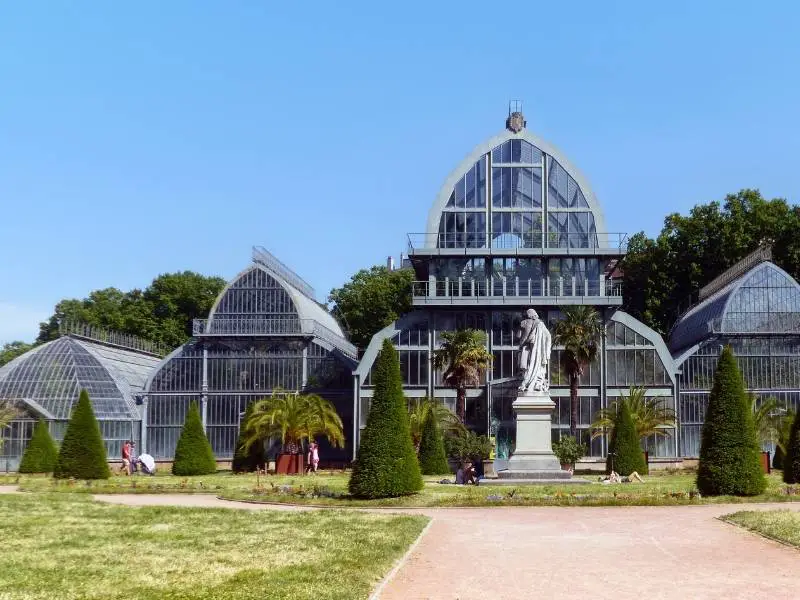
The Parc de la Tête d’Or, with its vast expanse, offers a multitude of attractions. It’s not just about leisurely strolls amidst the trees, serenaded by the chirping of birds. The park boasts a rose garden, a botanical garden, and a zoological park where you can encounter species you’ve never seen before.
But that’s not all! The Parc de la Tête d’Or is also a hub for family-friendly activities. Spend a day bonding over mini boat rides, cycling, and more. Enjoy a simple scenic tour of the park on the carousel or the train with your kids. With playgrounds, mini-karts, and bikes for rent, there’s never a dull moment at Parc de la Tête d’Or.
Learn more about the park from their official website (French).
Best Time to Visit Lyon
Are you now thinking about taking a trip to Lyon? So, when?
As the home to exceptional gastronomy that remains a constant in the city, Lyon is a year-round destination, especially if you’re a food enthusiast. Lyon’s food scene is vibrant all year long, and each season brings its own special dishes and flavors to savor.
However, if sightseeing is also on your agenda, the best time to explore Lyon is from late spring to mid-autumn. Lyon’s weather during this period is generally more favorable, with May signaling the start of increasingly pleasant and sunny conditions.
However, if you seek a quieter experience and are comfortable with cooler temperatures, exploring Lyon during the off-season, typically from November through early April, has its perks. This option offers a range of advantages, including a more tranquil atmosphere, fewer crowds, budget-friendly airfare, train tickets, and hotel rates, along with the opportunity to immerse yourself in the city’s local life.
Lastly, Lyon hosts a variety of events throughout the year that cater to different interests. Here are some events that you should watch out for:
- Lyon BD Festival (June): This is a festival all about graphic novels. If you’re a fan, this is a must-see.
- The Fourvière Nights (June to July): Imagine a series of concerts and performances in an ancient theater. Sounds pretty cool, right?
- Woodstower (August): This eco-festival happens at the end of summer on the edge of the lake at Grand Parc de Miribel-Jonage. It’s all about celebrating nature and having a good time.
- The European Heritage Days (September): This is when Lyon really shows off its rich cultural heritage. There’s a lot to see and do during this event.
- The Dance Biennial (September): Love dance? This event showcases performances from dance companies around the globe.
- The Lumière Festival – Grand Lyon Film Festival (October): This one’s for the movie buffs. It’s a film festival dedicated to classic cinema.
- Fête des Lumières (December): This is a light festival that turns the city into a dazzling spectacle. It’s truly something to behold.
Here is the calendar of events in Lyon.
How Long to Spend in Lyon
Well, are you now decided to visit Lyon? If your main goal is to see only the highlights and landmarks of Lyon, spending 2 days in the city would be sufficient. This allows you to visit the essential sites such as the Basilica of Notre-Dame de Fourvière, the historic district of Vieux Lyon, and a few museums like the Confluence.
If your main focus is indulging in a food trip with a bit of sightseeing, two days should suffice. In this time frame, you can delve into Lyon’s diverse food scene, including trying out bouchons and exploring local markets. For a well-rounded visit to Lyon, three days would be ideal if you want to fully immerse yourself in the city’s renowned gastronomic scene and explore its key attractions.
If you like, you can dedicate each day to a different type of cuisine!
Some of the must-try local dishes include Rosette lyonnaise, Saucisson de Lyon (sausage), Andouillette (a sausage made from coarsely cut tripe), Salade lyonnaise (lettuce with bacon, croutons, and a poached egg), and Quenelles (ground fish dumplings).
How to Get to Lyon
As France’s third largest city, Lyon is very straightforward to visit. If you’re planning a trip to Lyon there are several convenient options available.
For those already in France, a train ride from Paris to Lyon is a quick and easy option, taking just around two hours. If you prefer to drive, the journey from Paris to Lyon by car is approximately four and a half hours.
Alternatively, you can catch a flight from Paris Charles de Gaulle to Lyon, which typically takes about three hours and sixteen minutes. For international travelers, Lyon-Saint-Exupéry Airport offers direct flights from various locations including the U.K., Spain, Germany, Morocco, Senegal, Algeria, Tunisia, Canada (Montreal), Turkey, and Armenia.
Additionally, direct train services connect Lyon with Geneva (Switzerland), Brussels (Belgium), Frankfurt (Germany), and Milan (Italy).
Where to Stay in Lyon
When it comes to finding the perfect place to stay in Lyon, you’re spoiled for choice. Here are some of the top neighborhoods you might want to consider:
First, La Presqu’Ile. It is right in the heart of the city, making it a great choice for first-time visitors. It’s a shopper’s paradise with plenty of restaurants and stunning views of the Rhone River. However, keep in mind that this central location can come with a higher price tag.
Second, Old Town Lyon, or Vieux Lyon. It is a charming and historic neighborhood that could be an excellent choice for accommodation, but it also has its drawbacks. Here are some reasons why you might want to choose it, and some reasons why you might not.
Pros:
- Historic Charm: As one of Europe’s largest and best-preserved Renaissance neighborhoods, Vieux Lyon offers a unique atmosphere with its 16th-century architecture.
- Culinary Delights: The area has some of the best and hidden gem restaurants, making it easy for foodies to culinary experience.
- Accessibility: Many of Lyon’s key attractions are within walking distance, making it a convenient base for sightseeing.
Cons:
- Tourist Crowds: Given its popularity, Vieux Lyon can be crowded, particularly during peak tourist season.
- Night Noise: The area has a vibrant nightlife which could mean noise late into the night.
Next, La Guillotière. Situated in Lyon’s 7th district, It is recognized for being a budget-friendly neighborhood in comparison to some others in the city. Still, it’s worth noting that costs may fluctuate based on your choice of accommodation and the season you visit.
Confluence is one of Lyon’s trendiest neighborhoods. Lyon’s Confluence offers a modern atmosphere with contemporary architecture, cultural attractions like the Confluence Museum, and scenic waterfront views along the Rhône and Saône rivers. However, it’s slightly removed from the historic charm of Old Lyon and may have a quieter nightlife scene.
Prices for accommodations in Confluence can also be higher compared to other parts of the city, so consider your priorities when choosing this neighborhood.
To easily find the hotel that’s most convenient for your visit to Lyon, here’s a hotel browser where you can discover the best hotel deals in the city. It includes a map that allows you to locate the hotel that best suits your preferred location.
Getting Around Lyon
When exploring Lyon, renting a car is often unnecessary, especially if your focus is primarily on the city itself.
Renting a car can add expenses, parking can be costly, and it’s generally not the most practical way to navigate the city. Consider car rental only if you intend to embark on multiple day trips, such as exploring nearby winemaking regions and villages like Beaujolais or visiting destinations in the French Alps.
The Lyon Metro system is the most convenient choice for travelers moving from one point to another in the city. It comprises four lines connecting the city center, nearby suburbs, and key attractions such as Old Lyon, Place Bellecour square, the Presqu’île district, City Hall, and the Croix-Rousse neighborhood. The Metro operates daily from 5 a.m. to 12 a.m.
Besides the Metro, Lyon’s tramway network provides an additional hassle-free transportation option. You might want to consider purchasing the Lyon City Card, providing unlimited access to all metro, bus, tram, and funicular lines.
This card serves as the perfect pass for exploring Lyon and maximizing your visit, granting entry to 23 museums and unrestricted use of the entire TCL network, including the Metro, Tram, Bus, and Funicular. Check the price for Lyon City Card here.
Guides and Tours in Visiting Lyon
If you’re planning a trip to Lyon and need some guidance to make your journey smoother and more insightful, this list of travel guides will surely be of great help. Each guide offers a unique perspective and valuable information about the city, its culture, attractions, and much more.
Just click on the one that interests you the most to learn more:
Explore The South of France After Lyon
Beyond everything I’ve highlighted so far, another advantage of visiting Lyon is its nearness to the breathtaking locations in the south of France. This includes Annecy, renowned as one of the most beautiful towns in the southeastern part of the country.
It’s worth noting that the south of France boasts charming villages that are quaint, scenic, and filled with romance! Check out the list below featuring 10 most beautiful villages in the south of France. I’ve also suggested some top things to do for each village.
- Gordes: See the amazing stone buildings and the lavender fields near this hilltop village. Don’t miss the beautiful abbey nearby.
- Eze: Ride a bus to this cliffside village with medieval charm. Enjoy the views from the gardens and the perfume shops.
- Rocamadour: Visit the sacred places and churches of this old pilgrimage site. See the stunning views of the valley from the castle.
- Moustiers-Sainte-Marie: Explore the pottery shops and the lovely streets of this village. Hike up to the chapel for a great view.
- Aigues-Mortes: Walk on the medieval walls and towers of this fortified town. See the pink salt lakes and the animals of Camargue.
- Carcassonne: Explore the castle and the walls of this World Heritage Site. Feel the medieval vibe and culture of the old town.
- Chamonix: Take a cable car to see Mont Blanc and the Alps from above. Have fun skiing, hiking, or paragliding in this town.
- Domme: Discover the cave with stalactites and ancient paintings in this village. See the river and valley from the viewpoint.
- Saint Paul De Vence: See the artworks of famous artists like Picasso and Matisse in this artistic village. Walk around the streets and galleries.
- Saint-Cirq-Lapopie: See the medieval houses and monuments of this picturesque village. Take a boat or a hike along the river.
Save it on Pinterest.
